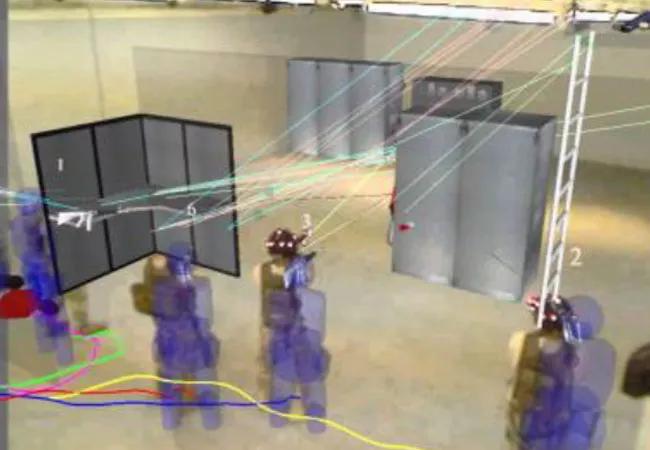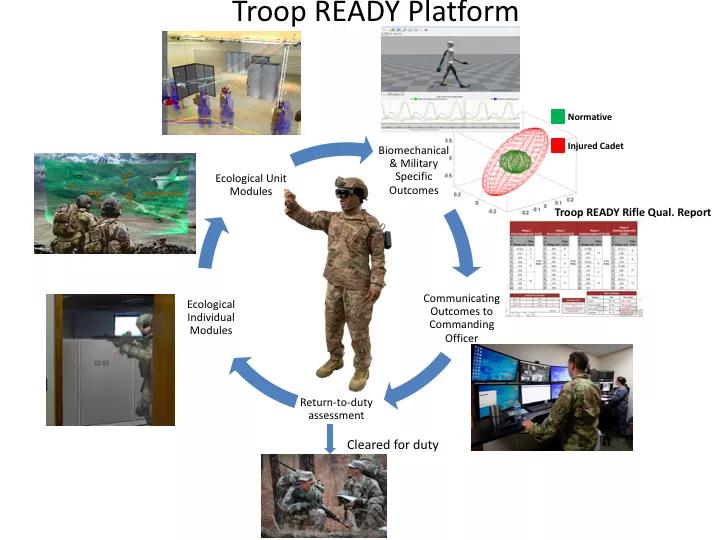Advertisement
DoD grant supports creation, validation of multidimensional field assessments
After a soldier suffers a mild traumatic brain injury (mTBI), accurate determination of readiness for resuming duty is critical to the safety of both the soldier and his or her unit. To this end, the U.S. Department of Defense (DoD) has granted a $2 million award to a Cleveland Clinic-led team of researchers to develop and validate cognitive and motor assessments of service members while they simulate military activities using an augmented reality headset.
Advertisement
Cleveland Clinic is a non-profit academic medical center. Advertising on our site helps support our mission. We do not endorse non-Cleveland Clinic products or services. Policy
“This grant will enable us to develop systematic, objective, affordable, accurate assessments that can quickly be conducted in the field or clinical setting,” says lead investigator Jay Alberts, PhD, Director of the Concussion Center and Vice Chair of Innovation for Cleveland Clinic’s Neurological Institute. “The basis of these assessments in military-relevant augmented reality makes them ideally suited to evaluate return-to-duty capability.”
The grant builds on earlier work by Dr. Alberts’ team assessing soldiers after mTBI using augmented reality programs (detailed in this Consult QD post) and using sensors in iPads to quantify postural stability in athletes following concussion (Neurology. 2014;82(10 suppl):P1.314).
With the new DoD grant, the team will collaborate with military experts and a veteran combat medic to create a series of mixed-reality assessments to simulate the unique demands associated with military service while simultaneously providing data that quantify cognitive and motor performance. The software will be written in the cross-platform game engine known as Unity to ensure use across a number of augmented reality platforms.
The Microsoft HoloLens augmented reality device, which will serve as the initial platform, contains an optical camera system and inertial measurement unit (IMU). Dr. Alberts’ group has previously developed methods and software to gather positional data from the IMU to calculate precise biomechanical outcomes of human performance.
Three modules of the Troop READY platform (short for Readiness Evaluation with Augmented Reality Return-to-Duty) will ultimately be created for completion by service members. All modules emphasize dual testing — i.e., simultaneous rather than discrete assessment of cognitive and motor abilities — which better mirrors the real-world demands that service members encounter. The modules have distinct focuses of increasing complexity:


Images from augmented reality playbacks of a soldier moving through a combat simulation scenario (top) and an initial team assessment module (bottom).
Advertisement
The modules will incorporate physical, cognitive and psychosocial domains of function to cover a range of characteristics critical to determining return-to-duty readiness (see figure below). Components include pairing cognitive tasks with physical activity, auditory and visual challenges, decision-making under a high-stress environment and ability to interact and function effectively within a unit.

According to Dr. Alberts, the best currently available programs for evaluating an injured soldier’s return-to-duty capabilities following head injury have several major drawbacks. An assessment may take days to administer, requiring a team of trained personnel for specialized testing, and a single system typically costs millions of dollars.
In contrast, the Troop READY system is anticipated to cost about $8,000 and can be rapidly administered in the field or a clinical setting by an individual. Standardization of decision making and continuity of care will be facilitated by the ability to immediately communicate outcomes data to central commanding officers and medical personnel. “Common data elements that all parties are familiar with are used to improve return-to-duty decision-making,” Dr. Alberts explains.
The project also includes biomechanical evaluation. Biomechanical data derived from 65 civilians undergoing the new HoloLens modules will be compared with assessments using the Cleveland Clinic Postural Stability Index (CC-PSI), a tool employing a 3D motion capture system that’s been validated on nearly 7,000 student athletes for return-to-play evaluation following concussion (Med Sci Sports Exerc. 2018;50:1998-2006).
Advertisement
After validation, a normative study of the modules will be conducted on 330 service members (165 cadets/officers and 165 enlisted personnel). Previous studies have indicated differences in either physical or cognitive measures during concussion recovery between men and women, athletes of different ages, civilians and service members, and enlisted service members and cadets/officers.
“Because there can’t be baseline data on each soldier in the field, having solid normative data is critical to informing decisions about duty readiness after a head injury,” Dr. Alberts observes. “Our extensive validation process will result in greater predictive value for each individual.”
While the grant will focus on assessment for resuming combat duty, Dr. Alberts notes that the technology developed is expected to also advance TBI rehabilitation management for active service members, veterans and civilians.
“We expect this DoD augmented reality award will yield important benefits for clinical use,” he says. “It will provide foundational technology for a number of planned applications around TBI and stroke rehabilitation, as well as for deep brain stimulation programming in Parkinson disease.”
Advertisement
Advertisement

Real-world claims data and tissue culture studies set the stage for randomized clinical testing

New grant-funded investigation illustrates impact and reach of Cleveland Clinic Brain Study

How the new longitudinal investigation could become the Framingham Heart Study of brain health

Pilot findings show good patient acceptance and safety, early hints of efficacy

Study finds high prevalence of symptoms, willingness to seek treatment

Panel outlines research priorities around a promising alternative to imaging markers

Suspected factors include antithrombotic intensity, time on device, presence of thrombocytopenia

Preclinical studies will assess whether method developed for stroke recovery curbs deficits after brain injury